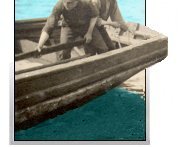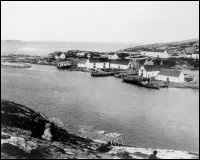 |

 |
|
- The Move
A video on the resettlement of the Rumboldt family
in 1968.
|
|
|
|
|
 |
Home  Virtual Exhibits Virtual Exhibits  Resettlement Resettlement  Battle Harbour Battle Harbour
Battle Harbour
Described by Bishop Feild in 1851 as “probably the oldest, as well as the largest settlement on the Labrador Coast,”
Battle Harbour evolved from a seasonal fishing station to a permanent settlement and mercantile centre in southeastern
Labrador. In the last quarter of the 18th century, John Slade and Company of Poole, Dorset had built extensive mercantile
premises there. The Slade company engaged in the saltfish trade and sealing, supplying crews with their needs in exchange for
their produce each season. Battle Harbour also became a centre for supplying the Labrador "floater" fishery prosecuted by crews
from the island of Newfoundland who came each spring on their schooners. This brisk commercial trade maintained a stable, though
small population at Battle Harbour of about 200 by 1848. In that year Bishop Feild consecrated the first cemetery which, not
surprisingly, had headstones imported from Poole. St. James Anglican Church, the first church at Battle Harbour, was constructed in 1857. In 1871, Baine, Johnston and Company acquired the Slade operation. Baine, Johnston ran the operation
until 1955 when it sold the premises to Earle Brothers Freighting Services. However by then the community had begun to decline.
When fire devastated Battle Harbour in 1930, the new school, hospital and outbuildings were built at Mary's Harbour on the mainland,
11 kilometres away. The relocation of these services combined with the decline of the salmon and cod fisheries after Confederation,
led to the resettlement of the community around 1966. In that year, an amendment to the Federal-Provincial Resettlement Program
allowed individual households to move from "designated outports." This prompted many people in southeastern Labrador to relocate,
including 14 Battle Harbour families consisting of 59 residents who had moved to Mary's Harbour by 1970. Some families continued
to maintain their property there and returned each season to prosecute the fishery. Earle Brothers continued to operate at Battle
Harbour until the decline of inshore fisheries in the early 1990s, when the Battle Harbour Historic Trust acquired the property.
The Trust has preserved and restored the old premises and other properties at Battle Harbour, resulting in its designation as a
national historic site. Now regarded as one of the province's "signature attractions," many travellers from around the world visit
Battle Harbour each year. The images capture the extent and layout of the mercantile premises in the early 1900s and after
restoration at the end of the century.

Baine, Johnson & Company Fishing premises, Battle Harbour
Larger Version |

Baine, Johnson & Company Fishing premises, Battle Harbour
Larger Version |
|
 |
 |


